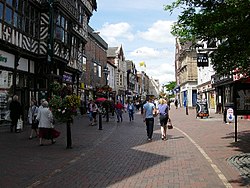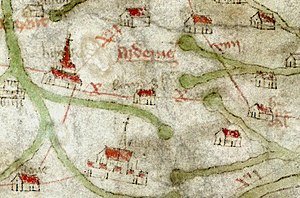Stafford
| Stafford | |
| Staffordshire | |
|---|---|
 Stafford town centre | |
| Location | |
| Grid reference: | SJ922232 |
| Location: | 52°48’24"N, 2°7’2"W |
| Data | |
| Population: | 63,681 (2001) |
| Post town: | Stafford |
| Postcode: | ST16, ST17 |
| Dialling code: | 01785 |
| Local Government | |
| Council: | Stafford |
| Parliamentary constituency: |
Stafford |
Stafford is the county town of Staffordshire. It lies approximately 16 miles north of Wolverhampton and 18 miles south of Stoke-on-Trent.
Stafford is part of the ancient Pyrehill hundred.
Things to see in the town
St Chad's Church
The oldest building in Stafford is St Chad's Church with a history reaching back into the twelfth century,[1] and possibly beyond. The main part of the church is richly decorated; patterns and figures have been carved into almost every archway and pillar. The carvings may have been made by a group of stonemasons from the Middle East who came to England during the Crusades. A great deal of the stonework was covered up during the 17th and 18th centuries, and the church took on a neo-classical style. In the early 19th century restoration work was carried out on the church and the Norman decoration was rediscovered.
Today the Church hosts "Timewalk", a computer generated display which relates the journey of history and mystery within the walls of the church. Voices from the past, including one of Stafford's most famous characters - Izaak Walton - guide you through the 900 years of the church's history, while dramatic lighting and sound effects enliven the story. St Chad's central location opposite the Swan Hotel and near the Ancient High House on Greengate Street places it firmly on the heritage trail. It is often referred to as 'Stafford's Hidden Gem'.
Castle
In 1100 the Normans built a motte and bailey castle. It was later upgraded by Earl Ralph in 1347 by building a stone keep. During the early 19th century repairs were begun but were never completed and the keep fell into ruin during the 20th century.
Leisure
Opened in 1908, Victoria Park is a 13-acre Edwardian riverside park with an open-air paddling pool, bowling green, bird cages, greenhouses and two play areas.
Stafford Gatehouse Theatre is the town's main entertainment and cultural venue. An arts centre has also been planned for the town to offer more culture and try and boost tourism in the town.
In the main shopping street, Greengate Street, lies the Elizabethan Ancient High House, the largest timber-framed town house in England. [2] The Ancient High House is now a museum, with changing exhibitions.
Shire Hall

Built in 1798 as a court house and office of the Mayor and Clerk of Stafford,[3] The Shire Hall Gallery, found in the very centre of Stafford town, houses the Art Gallery, which shows changing exhibitions. It also contains a café and the town's Library.
The Shire Hall used to be the Court House for the town, and as a Grade II listed building, still retains two courtrooms. One of these is open to the general public and has a permanent exhibition showing the history of the building, some high profile cases that were heard there and guided tours are available. Part of the tour includes an old 'holding cell' which is open to public viewing.
Cobblers
Stafford has a long history of shoe making. It is "an ancient borough and market town, celebrated for the manufacture of shoes."[4] Furthermore, "in the eighteenth century Stafford was represented (in Parliament) by the famous playwright Richard Brinsley Sheridan. When he was in Stafford he would stay with his friend William Horton. Horton was the founder of the Stafford Shoe Industry. A century after Horton began the early Factory System, Stafford was exporting some 5,000,000 pairs of shoes to South Africa alone. The were a number of spin-off industries which prospered in Stafford, these including Venables Wood Yard, Spic and Span Polish later to become Dove then Evode. The shoe industry gradually died out in the town; Lotus Shoes was the last manufacturers."[5] The large red-brick Lotus Shoe factory on Sandon Road closed and was demolished about 2001 to be quickly replaced by modern housing.
See for example: Staffordshire Industrial Archaeology Society, Journal No 10 (1981) including: A M Harrison, The Development of Boot and Shoe Manufacturing in Stafford 1850-1880; Staffordshire Industrial Archaeology Society, Journal 19 (2005), Shoemaking in Stafford, containing: The Development of Boot and Shoe Manufacturing in Stafford, 1850–1880, by Martin Harrison, Richard Podmore & Son, Shoe Manufacturers, by Martin Harrison, Stafford Box Factory in 2003, by Martin Harrison[6]
History
Stafford means "staithe ford", which is to say a ford at a beach or landing place. The original settlement was on an island in the middle of the marshes of the River Sow, a tributary of the River Trent, and there is still a large area of marshland northwest of the town, which has always been subject to flooding, as it was in 1947, 2000 and 2007.

In the year 913 Stafford was fortified by Æthelflæd, Lady of the Mercians and daughter of Alfred the Great. It became the new capital of Mercia, the previous capital's having been in or near Stone. Queen Æthelflæd ruled Mercia from Stafford for five years after the death of her husband. It was around this time the county of Stafford was formed. King Alfred's son Edward, with the crucial aid of Æþelflæd finally conquered and Christianised the Danes who had settled in the Midlands.
Stafford Castle was built by the Normans on a nearby hilltop in 1070, four years after the Norman invasion in 1066. It was first made of wood, and later rebuilt of stone. It has been rebuilt twice since, but now only 19th century ruins remain atop the impressive earthworks. Illumination of the castle at night-time has made it a landmark for motorists on the M6 motorway and train travellers on the West Coast Main Line.
There are two ancient churches in Stafford, St Chad's which was probably founded in Anglo-Saxon times, and St Mary's Collegiate Church, which is now a Grade I listed building.
In 1206, King John granted a Royal Charter which created the Borough of Stafford. On 31 March 2006 Her Majesty Queen Elizabeth II visited the town to join in the 800th anniversary civic celebrations.
The Stafford knot

The Stafford knot is a heraldic device which has become associated with the town and with Staffordshire.
The device is a distinctive representation of a simple overhand knot. It was the badge of the de Stafford family and has become the ubiquitous symbol for Staffordshire and of its county town, appearing in many heraldic devices, and in the badge of the Staffordshire Regiment.
References
Outside links
- Stafford Tourism Bureau
- Stafford Town Centre Web Site
- Ancient High House
- Lyrics and a live performance video of the Stafford Song
- Pictures & stories about the shoe industry in Stafford
- History of Doxey
- Stafford Borough Council site re a short history of the town
- an illustrated history of the town
- Stafford, a visitors' guide
- Staffordshire Past-Track